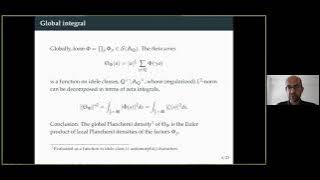
The Plancherel formula for L^2(GL_n(F)\GL_n(E)) and applications… - Raphael Beuzart-Plessis
Workshop on Representation Theory and Analysis on Locally Symmetric Spaces Topic: The Plancherel formula for L^2(GL_n(F)\GL_n(E)) and applications to the Ichino-Ikeda and formal degree conjectures for unitary groups Speaker: Raphael Beuzart-Plessis Affiliation: CNRS Date: March 6, 2018 Fo
From playlist Mathematics

Yiannis Sakellaridis: Plancherel formula, intersection complexes, and local L-functions
In the theory of automorphic forms, L-functions (and their special values) are usually realized by various types of period integrals. It is now understood that the local L-factors associated to a period represent a Plancherel density for a homogeneous space. I will start by reviewing the c
From playlist Seminar Series "Arithmetic Applications of Fourier Analysis"

C73 Introducing the theorem of Frobenius
The theorem of Frobenius allows us to calculate a solution around a regular singular point.
From playlist Differential Equations

Proof of Lemma and Lagrange's Theorem
Please Subscribe here, thank you!!! https://goo.gl/JQ8Nys Proof of Lemma and Lagrange's Theorem. This video starts by proving that any two right cosets have the same cardinality. Then we prove Lagrange's Theorem which says that if H is a subgroup of a finite group G then the order of H div
From playlist Abstract Algebra

Alexander Bufetov: Determinantal point processes - Lecture 1
Abstract: Determinantal point processes arise in a wide range of problems in asymptotic combinatorics, representation theory and mathematical physics, especially the theory of random matrices. While our understanding of determinantal point processes has greatly advanced in the last 20 year
From playlist Probability and Statistics

I continue the look at higher-order, linear, ordinary differential equations. This time, though, they have variable coefficients and of a very special kind.
From playlist Differential Equations

A beautiful combinatorical proof of the Brouwer Fixed Point Theorem - Via Sperner's Lemma
Using a simple combinatorical argument, we can prove an important theorem in topology without any sophisticated machinery. Brouwer's Fixed Point Theorem: Every continuous mapping f(p) from between closed balls of the same dimension have a fixed point where f(p)=p. Sperner's Lemma: Ever
From playlist Cool Math Series

Lec 9 | MIT 6.450 Principles of Digital Communications I, Fall 2006
Lecture 9: Discrete-time fourier transforms and sampling theorem View the complete course at: http://ocw.mit.edu/6-450F06 License: Creative Commons BY-NC-SA More information at http://ocw.mit.edu/terms More courses at http://ocw.mit.edu
From playlist MIT 6.450 Principles of Digital Communications, I Fall 2006

Integral Transforms - Lecture 9: The Fourier Transform in Action. Oxford Maths 2nd Year Lecture
This short course from Sam Howison, all 9 lectures of which we are making available (this is lecture 9), introduces two vital ideas. First, we look at distributions (or generalised functions) and in particular the mathematical representation of a 'point mass' as the Dirac delta function.
From playlist Oxford Mathematics Student Lectures - Integral Transforms

Asymptotic invariants of locally symmetric spaces – Tsachik Gelander – ICM2018
Lie Theory and Generalizations Invited Lecture 7.4 Asymptotic invariants of locally symmetric spaces Tsachik Gelander Abstract: The complexity of a locally symmetric space M is controlled by its volume. This phenomena can be measured by studying the growth of topological, geometric, alge
From playlist Lie Theory and Generalizations

Ptolemy's theorem and generalizations | Rational Geometry Math Foundations 131 | NJ Wildberger
The other famous classical theorem about cyclic quadrilaterals is due to the great Greek astronomer and mathematician, Claudius Ptolemy. Adopting a rational point of view, we need to rethink this theorem to state it in a purely algebraic way, without resort to `distances' and the correspon
From playlist Math Foundations

We finally get to Lagrange's theorem for finite groups. If this is the first video you see, rather start at https://www.youtube.com/watch?v=F7OgJi6o9po&t=6s In this video I show you how the set that makes up a group can be partitioned by a subgroup and its cosets. I also take a look at
From playlist Abstract algebra

The Green - Tao Theorem (Lecture 3) by D. S. Ramana
Program Workshop on Additive Combinatorics ORGANIZERS: S. D. Adhikari and D. S. Ramana DATE: 24 February 2020 to 06 March 2020 VENUE: Madhava Lecture Hall, ICTS Bangalore Additive combinatorics is an active branch of mathematics that interfaces with combinatorics, number theory, ergod
From playlist Workshop on Additive Combinatorics 2020

Parseval-Plancherel Identity | Normalization in Quantum Mechanics
In this video, we will investigate the Parseval-Plancherel identity, which is named after the French mathematician Marc-Antoine Parseval, and the Swiss mathematician Michel Plancherel. It states that the integral over the absolute square of a function does not change after a Fourier transf
From playlist Quantum Mechanics, Quantum Field Theory

Cauchy-Riemann Equations: Proving a Function is Nowhere Differentiable 1
Please Subscribe here, thank you!!! https://goo.gl/JQ8Nys Using the Cauchy-Riemann Equations to prove that the function f(z) = conjugate(z) is nowhere differentiable. This is a straightforward application of the C.R. equations.
From playlist Complex Analysis

Jérémie Bouttier : Autour de la mesure de Plancherel sur les partitions d'entiers - Partie 1
Résumé : Le but de ce cours sera de présenter quelques techniques liées aux processus de Schur, dans le cadre le plus simple de la mesure de Plancherel sur les partitions d'entiers. La mesure de Plancherel est une mesure sur l'ensemble des partitions d'un entier n, où une partition donnée
From playlist Probability and Statistics

Moving on from Lagrange's equation, I show you how to derive Hamilton's equation.
From playlist Physics ONE

Functional Analysis Lecture 07 2014 02 11 Riesz Interpolation Theorem, Part 2
Proof of theorem in case of general L^p functions. Using Riesz interpolation to extend Fourier transform. Rapidly decreasing functions; Schwartz class functions. Fourier transform of a Schwartz class function. Properties of Fourier transform (interaction with basic operations); Fourie
From playlist Course 9: Basic Functional and Harmonic Analysis